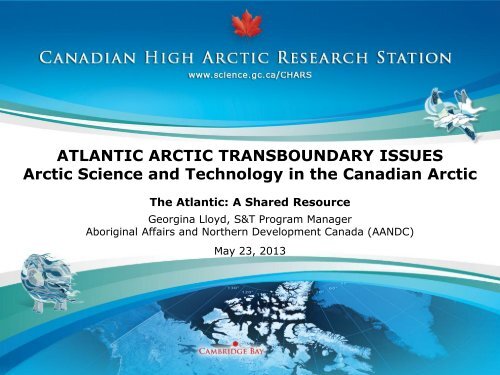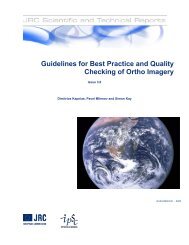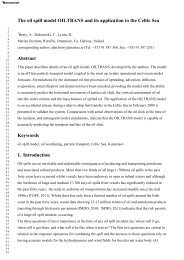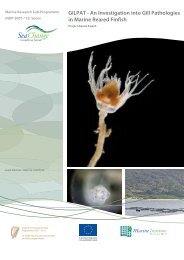Canadian perspectives: Ms Georgina Lloyd - Marine Institute
Canadian perspectives: Ms Georgina Lloyd - Marine Institute
Canadian perspectives: Ms Georgina Lloyd - Marine Institute
You also want an ePaper? Increase the reach of your titles
YUMPU automatically turns print PDFs into web optimized ePapers that Google loves.
ATLANTIC ARCTIC TRANSBOUNDARY ISSUES<br />
Arctic Science and Technology in the <strong>Canadian</strong> Arctic<br />
The Atlantic: A Shared Resource<br />
<strong>Georgina</strong> <strong>Lloyd</strong>, S&T Program Manager<br />
Aboriginal Affairs and Northern Development Canada (AANDC)<br />
May 23, 2013
The Arctic-Atlantic connection and<br />
Canada’s Northern Strategy<br />
• Canada’s Arctic represents:<br />
– 25% of global Arctic<br />
– 40% of Canada’s territory<br />
– Largest archipelago in world<br />
• Wide range of Arctic<br />
ecosystems due to huge<br />
north-south gradient<br />
Sovereignty<br />
Exercising our Arctic<br />
sovereignty as<br />
international<br />
interest in the<br />
region increases.<br />
Social and Economic<br />
Development<br />
DOMESTIC AND INTERNATIONAL DIMENSION<br />
Encouraging social<br />
and economic<br />
development and<br />
regulatory<br />
improvements that<br />
benefit Northerners.<br />
Environmental<br />
Protection<br />
Adapting to climate<br />
change challenges and<br />
ensuring sensitive<br />
Arctic ecosystems are<br />
protected for future<br />
generations.<br />
Governance<br />
Providing<br />
Northerners with<br />
more control over<br />
their economic and<br />
political destiny.<br />
SCIENCE AND TECHNOLOGY UNDERPIN ALL FOUR PILLARS<br />
1
Engagement in <strong>Canadian</strong><br />
Arctic Science activities<br />
Science-based departments and<br />
others have broad mandates for<br />
managing resources, environmental<br />
protection, fostering knowledge<br />
Academic<br />
•Network of Centres of Excellence<br />
of Canada: ArcticNet<br />
•Canada Excellence Research Chairs<br />
(Arctic geomicrobiology, Remote<br />
sensing)<br />
•NSERC Discovery Frontiers ADAPT<br />
and CCAR<br />
Northerners<br />
•Research <strong>Institute</strong>s in each<br />
territory<br />
•Land claim organizations<br />
Industry and other<br />
•Oil and gas<br />
2<br />
•Mining
The Government of Canada’s<br />
Commitment to CHARS<br />
Our government will build a world-class arctic research<br />
station that will be on the cutting edge of arctic issues,<br />
including environmental science and resource<br />
development.<br />
This station will be built by <strong>Canadian</strong>s, in Canada's<br />
Arctic, and it will be there to serve the world.<br />
Cambridge Bay, Nunavut<br />
Population : 1477 (80% Inuit)<br />
Status<br />
Definition Feasibility<br />
Design Build Operate<br />
2013<br />
3
Mandated Priorities for the <strong>Canadian</strong><br />
High Arctic Research Station<br />
Mandated themes<br />
Resource<br />
Development<br />
Long–term outcomes<br />
• Resource development that is economically and environmentally<br />
sound and promotes social development<br />
• Renewable resources and unconventional energy sources that<br />
contribute to greater energy security and sustainability<br />
Exercising<br />
Sovereignty<br />
Strong and<br />
Healthy<br />
Communities<br />
Environmental<br />
Stewardship and<br />
Climate Change<br />
• Efficient and effective monitoring and surveillance of Canada’s<br />
vast Arctic<br />
• Effective management of Canada’s Arctic waters under changing<br />
conditions<br />
• Improved response to, and mitigation of, environmental and other<br />
disasters.<br />
• Improved infrastructure and diversified economic opportunities<br />
• Improved health outcomes and community wellness and resiliency<br />
• Effective environmental stewardship through greater knowledge of<br />
natural and human systems and their interconnections<br />
• Strengthened mitigation efforts through greater understanding of<br />
changes in the Arctic climate and the links to global systems, and<br />
increased capacity to adapt.<br />
4
Recommendations<br />
Establish collaborations that are built on new opportunities,<br />
existing capacities and fundamental to delivering on<br />
common and cross-cutting objectives<br />
e.g<br />
• Established Canada-EU-US working group<br />
• Monitoring coordination (SAON)<br />
• Sharing infrastructure resources (INTERACT)<br />
• Data sharing, standards, protocols<br />
5
Contact Us<br />
If you have comments or feedback on<br />
CHARS, please contact<br />
CHARS-SRCEA@aadnc-aandc.gc.ca<br />
<strong>Georgina</strong> <strong>Lloyd</strong>, S&T Program Manager Arctic Science<br />
Policy Integration<br />
georgina.lloyd@aadnc-aandc.gc.ca<br />
For more information about CHARS,<br />
please go to www.science.gc.ca/CHARS<br />
6

















